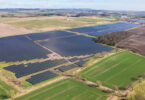Wind power generation in Britain reached a ten-year high in the three months to the end of September, according to a new report by Montel Analytics.
The study showed that levels of wind output recorded over the quarter was the highest for any Q3 since 2014, standing at 16.7TWh. Although this was down 3% on the previous quarter, it was up by 0.5TWh compared to Q3 2023.
The increase in wind generation resulted in higher levels of curtailment activities, as National Grid ESO encouraged wind farm operators to reduce output during periods of excess wind generation and low demand.
Due to high levels of wind generation during the wet and windy weather observed in the quarter, wholesale electricity prices rose by only 3% compared to Q2 despite an increase in gas prices driven by tensions in the Middle East, concerns over potential disruption of Russian gas flows through Ukraine, an extended outage at the second-largest US LNG export terminal due to Hurricane Beryl’s landfall in Texas and ongoing maintenance at Norwegian gas fields.
However, there were more periods of negative prices (50) in the day-ahead auctions – the most in any Q3 since 2020 which had been affected by abnormally low demand during the Covid lockdowns.
The Montel Analytics study also showed that Britain continued to be a net importer during the third quarter, with France and Norway the largest exporters into the GB market. Meanwhile, the Ratcliffe-on-Soar coal-fired plant was switched off for the last time at the end of the quarter, signalling the end of coal-fired generation in Britain.
Phil Hewitt, Director at Montel Analytics said: “Wind generation continued its upward trend as Britain looks to produce more of its electricity from cleaner sources. Curtailment of wind generation became necessary particularly during windy spells in early July, mid-August and early September, with record bid volumes being used to manage excess available wind output. Effectively, wind farm operators post bid prices at which they would be willing to reduce output if required and the system operator accepts bids as required to manage transmission constraints and/or excess levels of wind generation during periods of low demand on the system.”
“Although gas-fired generation increased slightly from 13.4TWh to 13.8TWh in the third quarter, this marks the second lowest quarterly CCGT generation output in our 20-year data series, which underscores the growing impact of renewable capacity in displacing conventional gas-fired generation. Of that, we estimate that up to around 2TWh of CCGT offers were made to offset the wind generation lost due to curtailment.”
Total generation in Britain excluding imports was 54.3TWh, a 3% decrease from the previous quarter and the lowest quarterly total since Q3 2022. However, imports continued to make a significant contribution to Britain’s power mix. This quarter saw a net energy import of 8.1TWh via interconnectors, significantly higher than net imports of 3.7TWh in Q3 2023 and a reversal of the 4.6TWh net exports in Q3 2022 when problems with the French nuclear fleet and high gas prices reduced supply from the continent.
Renewables accounted for 47.3% of the GB generation mix in Q3, with significant contributions from wind (16.7TWh), biomass (7.1TWh), solar (4.7TWh) and hydro (1.1TWh). Biomass output increased by 10%, hydro rose by 13% and solar generation reached its highest level for any Q3 since 2022, totalling 4.7TWh.
Gas-fired generation made up 22% of Britain’s power mix, with nuclear (17%) and imports (13%) accounting for the rest.
Related Energy articles:
Energy bills expected to be highest in these 10 areas this winter







